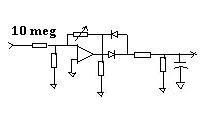They do not know how to measure their work.
Digital meters can be notoriously inaccurate for reading complex waveforms when one needs to split hairs.
Now the one thing we know that all these meters can do well is read DC voltage, so why not convert your input and output to a DC voltage?
I use 2 of these circuits, one for the input and one for the output.
First I hook them both up to the input.
Then I use the pots to adjust them to give identical readings.
Then put one on the output.
The 10meg input is high enough so that it is unlikely to load your circuit and sends a sample to the amp, is rectified and converted to DC.
Frankly I never believe peoples experiments out here that use digital meters for that reason. anyway.... hope this helps people get more reliable results.

Digital meters can be notoriously inaccurate for reading complex waveforms when one needs to split hairs.
Now the one thing we know that all these meters can do well is read DC voltage, so why not convert your input and output to a DC voltage?
I use 2 of these circuits, one for the input and one for the output.
First I hook them both up to the input.
Then I use the pots to adjust them to give identical readings.
Then put one on the output.
The 10meg input is high enough so that it is unlikely to load your circuit and sends a sample to the amp, is rectified and converted to DC.
Frankly I never believe peoples experiments out here that use digital meters for that reason. anyway.... hope this helps people get more reliable results.


Comment